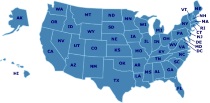Native Americans
Things to See & Do in Tennessee
Trail of Tears National Historic Trail
The Trail of Tears National Historic Trail commemorates the removal of the Cherokee and the paths that 17 Cherokee detachments followed westward. Today the trail encompasses about 2,200 miles of land and water routes, and traverses portions of nine states.
Natchez Trace Parkway
The 444-mile Natchez Trace Parkway commemorates an ancient trail that connected southern portions of the Mississippi River to salt licks in today’s central Tennessee. Over the centuries, the Choctaw, Chickasaw and other American Indians left their marks on the Trace. The Natchez Trace experienced its heaviest use from 1785 to 1820 by the “Kaintuck” boatmen that floated the Ohio and Miss. Rivers to markets in Natchez and New Orleans. They sold their cargo and boats and began the trek back north on foot to Nashville and points beyond. Today, visitors can experience this All-American Road through hiking, biking, horseback riding and camping. The Natchez Trace Parkway occupies areas in the states of Alabama, Mississippi, and Tennesee.
Cumberland Gap National Historical Park
Throughout the ages, poets, songwriters, novelists, journal writers, historians and artists have captured the grandeur of the Cumberland Gap. Thanks to the vision of Congress, who in 1940 authorized Cumberland Gap National Historical Park, visitors today can still bask in its beauty and immerse themselves in its rich history. The story of the first doorway to the west is commemorated at the national park, located where the borders of Tennessee, Kentucky, and Virginia meet. Carved by wind and water, Cumberland Gap forms a major break in the formidable Appalachian Mountain chain. First used by large game animals in their migratory journeys, followed by Native Americans, the Cumberland Gap was the first and best avenue for the settlement of the interior of this nation. From 1775 to 1810, the Gap's heyday, between 200,000 and 300,000 men, women, and children from all walks of life, crossed the Gap into "Kentuckee."
Featured Resources
As an Amazon Associate, we earn from qualifying purchases. We get commissions for purchases made through links on this site.
Idea Book For Cuisenaire Rods At The Primary Level
Grades K-4. Each 120 page book contains worksheets and has selected activities that cover the major math standards. Each page outlines the grade level, materials needed, settings, learning experiences, and are based on NCTM Standards.
Guiding Your Catholic Preschooler
There can be no greater delight in parenting than passing on the Faith to the next generation. To help with that glorious responsibility comes Guiding Your Catholic Preschooler, a parents handbook to home-based religious instruction for the youngest members of the family. Filled with practical ideas, developmental guidelines, and a contagious enthusiasm for the treasures of the Catholic Faith, this exciting guide makes raising truly Catholic kids one of life s greatest pleasures. Recommended in ...
Miserly Moms: Living on One Income in a Two-Income Economy
Save Thousands of Dollars a Year Jonni McCoy and her family are proof that you live on one income. The McCoys made a successful transition from two incomes to one while living in one of the most expensive parts of America: the San Francisco Bay Area. Her Miserly Guidelines will help you save thousands of dollars a year on everything from groceries to electricity to insurance and household cleaners—as well as reveal the hidden costs of holding a job and common money wasters. Her practical,...
Great States Board Game
What is the capital of NJ? Where is the Football Hall of Fame? These are just a few of the hundreds of questions players are asked as they adventure around the USA discovering state attractions and landmarks, capitals, state abbreviations, state locations and more. In order to answer the questions on the cards, players must look closely at the colorful USA map game board, becoming familiar with the geography of the country. Players must hurry to find the answers as the mechanical timer ticks. Co...





